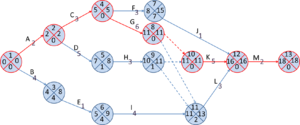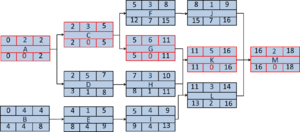Arrow diagram: Difference between revisions
From CEOpedia | Management online
(Infobox update) |
mNo edit summary |
||
| Line 13: | Line 13: | ||
</ul> | </ul> | ||
}} | }} | ||
'''Arrow diagram''' is a tool that graphically describes the relationship between planned activities, which make up the execution of a particular [[project]]. It graphically (visually) represents a deliberate [[plan]] of [[work]], paying attention to the critical operations and inventory time. This technique is related to critical path analysis. | '''Arrow diagram''' is a tool that graphically describes the relationship between planned activities, which make up the execution of a particular [[project]]. It graphically (visually) represents a deliberate [[plan]] of [[work]], paying attention to the critical operations and inventory time. This technique is related to critical path analysis. | ||
| Line 25: | Line 23: | ||
* Network diagram of steps | * Network diagram of steps | ||
[[File:arrow_diagram2.png|300px|right|thumb|Fig.1. Arrow diagram - Activity Diagramming Method (Activity on Arrow, AoA) version]] | |||
==General rules== | ==General rules== | ||
* Specify a list of actions necessary to complete a task ([[planning]] activities) | * Specify a list of actions necessary to complete a task ([[planning]] activities) | ||
| Line 31: | Line 30: | ||
==Procedure== | ==Procedure== | ||
[[File:arrow_diagram1.png|300px|right|thumb|Fig.2. Arrow diagram - Precendce Diagramming Method (Activity on Node, AoN) version]] | |||
# Define the proposed project (e.g. to determine the beginning and end of project) | # Define the proposed project (e.g. to determine the beginning and end of project) | ||
# Define a list of actions necessary to proceed with the project | # Define a list of actions necessary to proceed with the project | ||
Revision as of 14:37, 26 August 2020
| Arrow diagram |
|---|
| See also |
Arrow diagram is a tool that graphically describes the relationship between planned activities, which make up the execution of a particular project. It graphically (visually) represents a deliberate plan of work, paying attention to the critical operations and inventory time. This technique is related to critical path analysis.
It is one of new 7 quality tools together with affinity diagram, relations diagram, matrix diagram, matrix data analysis, tree diagram, process decision programme chart.
Other names of the tool:
- Network diagram
- Network operations
- Network diagram of steps
General rules
- Specify a list of actions necessary to complete a task (planning activities)
- Determine the interdependence of activities, such as mutual entailment (the action in order)
- Predict the time needed to implement the whole project, by estimating the duration of individual activities (with the adoption of the same unit of time)
Procedure
- Define the proposed project (e.g. to determine the beginning and end of project)
- Define a list of actions necessary to proceed with the project
- Estimate duration (execution) of the individual steps (should be the same unit of time)
- Define the order of occurrence of these steps (some steps may be performed simultaneously)
- Draw a diagram (network operations) (depending on the type of network should be drawn to mark the vertices and arrows, part of the graph operations and the execution time of each of them, sometimes supplemented with a diagram for additional information, such as the earliest and latest dates for commencement of operations, the unit responsible for their execution, etc.)
- The diagram analysis
- Define inventory time for each activity
- The designation of the critical path (longest path in the network, which determines the shortest possible time of completion of the project, in which there are critical steps, i.e. those that have no slack time)
- Calculate the time needed to complete the entire project
- Analyse the measures that should be used to implement the project within
See also:
References
- Salih O. Duffuaa, Mohamed Ben‐Daya, (1995) Improving maintenance quality using SPC tools, Journal of Quality in Maintenance Engineering, Vol. 1 Iss: 2
Author: Patrycja Celej

